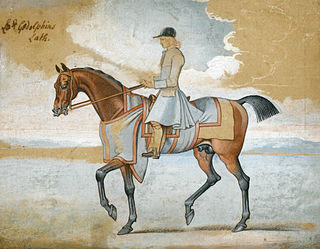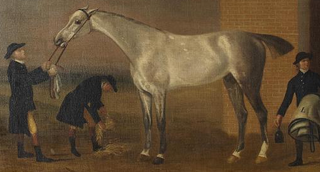Related Research Articles

The Godolphin Arabian, also known as the Godolphin Barb, was an Arabian horse who was one of three stallions that founded the modern Thoroughbred. He was named after his best-known owner, Francis Godolphin, 2nd Earl of Godolphin.

Colonel Benjamin Tasker Jr. was a politician and slave trader in colonial Maryland, and Mayor of Annapolis from 1754 to 1755. He was the son of Benjamin Tasker Sr., Provincial Governor of Maryland from 1752 to 1753.
Belair Stud was an American thoroughbred horse racing stable and breeding farm founded by Provincial Governor of Maryland Samuel Ogle in 1747 in Collington, Prince George's County, Maryland, in Colonial America.

The title of champion, or leading, sire of racehorses in Great Britain and Ireland is awarded to the stallion whose offspring have won the most prize money in Britain and Ireland during the flat racing season. The current (2023) champion is Frankel, who earned his first title in 2021.

Sir Archy was an American Thoroughbred racehorse considered one of the best racehorses of his time and later one of the most important sires in American history. He was inducted into the National Museum of Racing and Hall of Fame in the inaugural class of 1955.

Spark was a Thoroughbred stallion who was among the early imports of Thoroughbred horses to America. The Belair Stud stables were associated with him and a mare, Queen Mab, also imported in this period. Frederick, Prince of Wales gave the stallion to Samuel Ogle, the governor of Maryland, as a gift.
The Selima Stakes is an American Thoroughbred horse race held annually at Laurel Park Racecourse in Laurel, Maryland. Raced in late November, it is open to two-year-old fillies and is raced on turf.
Aimwell was a British Thoroughbred racehorse. In a career that lasted from autumn 1784 to spring 1786, he ran eight times and won five races. In 1785, he won the sixth running of the Epsom Derby as well as three races at Newmarket. He was beaten in his only race in 1786, and did not appear in any subsequent records.

Alcock's Arabian, also known as Pelham Grey Arabian and less certainly as Bloody Buttocks and Ancaster Turk, among other names, is the ancestor of all grey-coloured Thoroughbred horses, as well as grey sport and riding horses descended from Thoroughbred lines.
Rafalca is a former dressage horse, co-owned by Ann Romney, that performed in the equestrian competition at the 2012 Summer Olympics, with rider Jan Ebeling. She was retired from competitions in 2014, and is now a broodmare.
Curwen's Bay Barb was a foundation sire of the Thoroughbred breed. A bay horse with a white blaze, he was imported by Henry Curwen in 1698 from France. He had originally been a present to Louis XIV from the King of Morocco. One of his early sons, Mixbury, stood just over 13 hands high and apparently "there were not more that two horses of his day that could beat him under light wrights". He also sired Tantivy, Brocklesby, Brocklesby Betty, Creeping Molly and the top stallion Hip. It has also been suggested that he may have been the sire of Alcock's Arabian.
Blank (1740–1770) was a British Thoroughbred racehorse and sire. He only won one race, but became a very successful sire and was British Champion sire in 1762, 1764 and 1770.
Crab also known as Old Crab and Mr. Panton's Crab was a British Thoroughbred racehorse. After retiring from racing he became a successful stallion and was British Champion sire in 1748, 1749 and 1750. He was owned by the 1st Earl of Portmore until purchased by Mr. Cotton and then Thomas Panton.
Bloody Buttocks was a British Thoroughbred sire who was the leading sire in Great Britain and Ireland in 1739. He was owned by John Crofts.

Lath was a British Thoroughbred racehorse. He won at least four races, including a 1000-guinea sweepstakes at Newmarket and a match race against Squirt. After retiring from racing he became a stallion and produced a number of high-class runners and also sired the grand-dam of St. Leger winner Hollandoise.
Squirrel was a British Thoroughbred racehorse. He won seven of his nine races, including the 1400 Guineas Stakes and match races against Dapper and Jason. He was also a successful stallion, siring Craven Stakes winner Firetail. However he was more well known for producing broodmares, siring the dams of seven Classic winners including Derby winner Noble, along with the dam of champion sire Trumpator. Squirrel was owned by Jenison Shafto.
Imperatrix was a British Thoroughbred racehorse. She raced only twice, with her only win coming in the 1782 St. Leger Stakes. She was bred and owned by John Pratt. As a broodmare, Imperatrix produced nine foals.

Black Allan or Allan F-1 (1886–1910) was the foundation sire of the Tennessee Walking Horse. He was out of a Morgan and Thoroughbred cross mare named Maggie Marshall, a descendant of Figure and the Thoroughbred racing stallion Messenger; and sired by Allandorf, a Standardbred stallion descended from Hambletonian 10, also of the Messenger line.
Janus (1746–1780), also known as Little Janus, Young Janus, and Janus II, was an English Thoroughbred stallion imported to Colonial America, which would later become the United States. Noted for his quickness and compact conformation, he has subsequently been acknowledged as a foundation sire of the American Quarter Horse.

Medley (1776–1792) was a British Thoroughbred racehorse who was imported to the United States after the American Revolutionary War, becoming one of the foundation stallions of the American Thoroughbred.
References
- 1 2 3 4 5 Deubler, Cindy (May 2002), "Belair Museums stand in path of "Progress"", Mid-Atlantic Thoroughbred: 22–27
- 1 2 Remly, Lynn L. (Fall 2002), "Art Among the Oats: Belair Stable Museum", Equine Images, 2000 (81): 5–56
- 1 2 3 4 Eisenberg, John. "Off to the Races". HorseHints.org. Smithsonian Magazine. Retrieved August 27, 2023.
- ↑ "U.S. Thoroughbreds Rise to New Heights by 1800". International Museum of the Horse. Retrieved August 27, 2023.
- ↑ Carson, Jane (1965), Colonial Virginians at Play, Williamsburg, Virginia: Colonial Williamsburg, p. 125, ISBN 0-87935-122-5, OCLC 526839